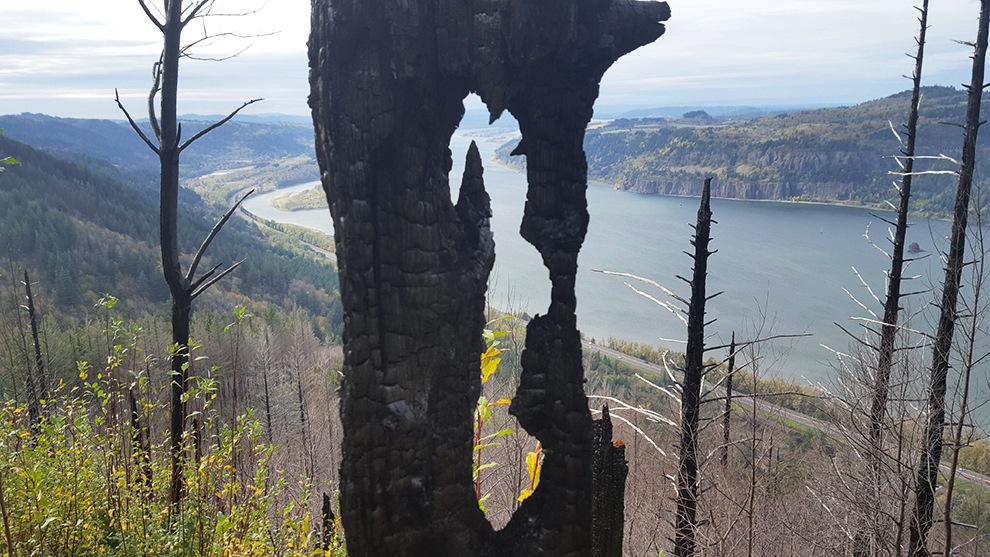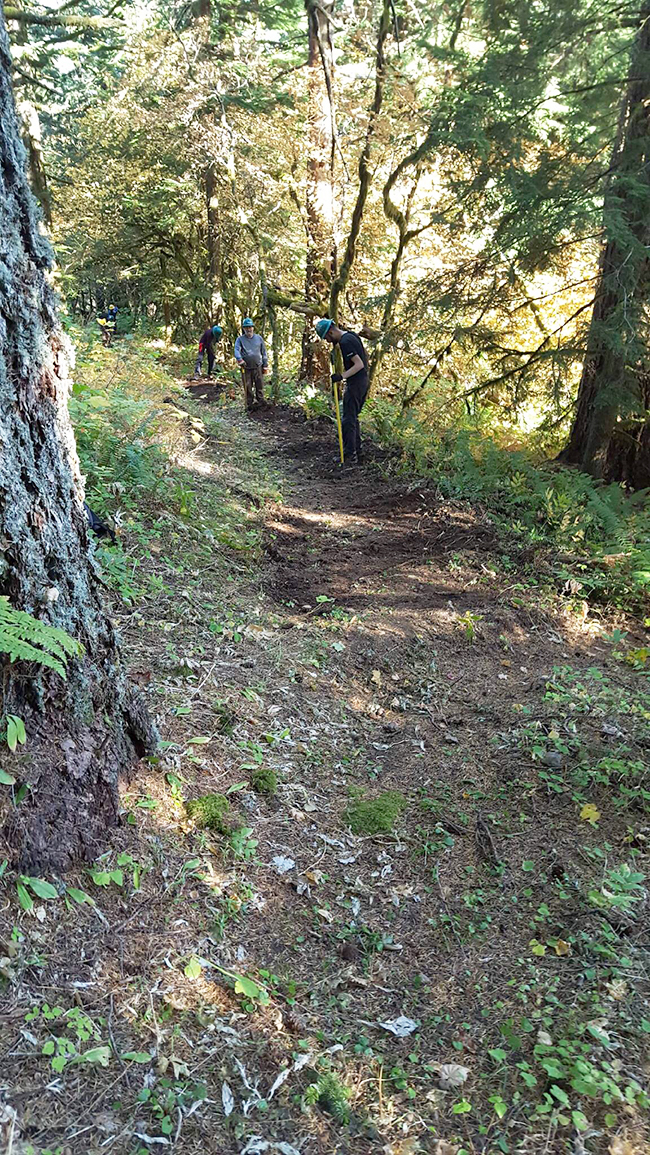AFTER THE FIRE: A TRAIL TO RESTORATION

Photo provided by Patrick Aitchison
After a year of waiting and uncertainty, hikers are slowly regaining access to the Oregon side of
the Columbia River Gorge, one of the state’s top recreation destinations. Getting trails reopened after the Eagle Creek Fire has required a lot of hard work and collaboration between parties.
On Sept. 2, 2017, sparked by a teenager’s carelessly tossed smoke bomb, the Eagle Creek Fire took off.
The fire raged across nearly 50,000 acres on the Oregon side of the Gorge before crews fully contained the blaze nearly three months later. Driven by powerful winds, smoke and ash blew into Troutdale, Gresham, and Portland, causing poor visibility and air quality. Due to their exhaustive efforts, fire crews kept the loss of man-made structures to a minimum, and thankfully there were no human casualties.
However, the Gorge landscape has been dramatically changed, and the vast network of trails that supported day hikers and backpackers experienced significant damage.
Over a year later, many trails on the Oregon side of the Gorge remain closed to the public due to hazards caused by the fire, including rockslides, fallen trees, and snags (standing dead trees) that could fall without warning. In some places, trails were covered in debris or washed away by subsequent winter rains, making them difficult to find on the forest floor.
Yet much work has been accomplished since last spring, with several trails once again open to the public, including the approach to Latourell Falls and the Pacific Crest Trail.
COLLABORATION HAS BEEN KEY
The Oregon side of the Columbia River Gorge comes under a patchwork of different ownerships, with much of the lower elevation land closest to the river managed by Oregon State Parks. Higher up, the lands to are mostly part of Mt. Hood National Forest, overseen by the U.S. Forest Service. Some privately owned parcels are interspersed, as well.
Because of this patchwork, collaboration has been necessary between multiple public and private entities in order to repair trails and restore access to hikers.
Along with the state and federal governments, one of the key players has been the nonprofit volunteer group Trailkeepers of Oregon (TKO).
TKO was established in 2007, in response to concerns that the Forest Service would close many trails due to lack of funds to address a long backlog of needed maintenance. The Forest Service currently has a trail crew of just two-to-six staff to cover more than 100 miles of trails on the Oregon side of the Gorge.
Now, TKO has been able to harness the energy and support of the many hikers who wanted to help out after the Eagle Creek Fire. First, though, TKO had to earn the trust of the state and Forest Service by showing its crews had the collective skill and expertise to tackle the complex challenges presented by the fire.
“It was a bit like a dating process,” says Steve Kruger, TKO executive director, as he described gaining the agency’s trust. The mutual effort started out cautious and tentative, then later, all sides felt confident enough to commit to longer-term endeavors.
Kruger remembers a specific instance last March when a Forest Service supervisor got a chance to see firsthand the restoration work of Kruger’s crew on the state-managed lower sections of the highly used Angel’s Rest Trail. After seeing how the TKO cleared, repaired, and improved those lower sections, the supervisor said, “You guys are good.” TKO got the green light to continue its work all the way to the federally-managed upper portions of Angel’s Rest.
Now, with multi-year cooperative agreements and work plans in place, TKO has helped rebuild many trails on the Oregon side of the Gorge. Kruger credits the Forest Service trail crew for its efficiency at addressing hazard trees, downed logs, and bridges that need repair. As for TKO’s own work, “We bring thoroughness,” he says, with enough volunteers to delve further into trail maintenance.
TKO crews direct runoff water away from trails, consider improvements to the tread, build retaining walls to keep trail switchbacks in place, and pay attention to the fine details. The volunteer work will easily be noticed as trails reopen: Despite the altered views produced by the fire – in some cases, unfortunate changes – hikers will likely find the paths themselves in the best condition they have ever been, as many routes had not seen such thorough care in years.
Patrick Aitchison, a Trailkeepers volunteer, recently attended work parties focused on the trails that loop to Devil’s Rest and Angel’s Rest. He describes a typical TKO meet-up: “We get a safety briefing, an overview of the plan for the day, then head up the trail with tools like Pulaskis (a combination axe/hoe hand tool favored by firefighters) and hand saws.”
Water bars are constructed to help reroute and drain rainfall, vegetation is cut back, and rocks might be moved or placed in an optimal way. Crew members must wear hard hats at all times, and if wind or weather makes conditions too dangerous to work in, leaders call off the work party and save that trail for another day.
One thing that surprised Aitchison: “How much vegetation has started growing in and over some trails, due to the lack of foot traffic over the last year,” he says. Oregon’s wet winter climate allows quick regrowth of certain plants in the absence of human impact.
WHAT HIKERS WILL SEE IN THE GORGE AFTER THE EAGLE CREEK FIRE
The Forest Service’s Columbia River Gorge web page contains a lot of information about the role of fire in natural ecosystems, as well as the specific story of the Eagle Creek Fire.
That story gives hikers an idea of what they will see when they next visit the Gorge. Most of the area had experienced aggressive fire suppression since the early 1900s, leading to a fairly uniform forest with even-aged trees and fewer open meadows and breaks in the tree cover than during historical times. Although last year’s fire stretched across 48,000 acres, not all of those acres burned at a high severity. This means that while some trees are visibly charred black and dead, other parts of the fire area still contain swaths of live, green trees or intermixed green and dead trees.
This “mosaic” pattern produced some benefits for the forest’s long-term health, despite the fire’s unnatural origin. The scope and mixed severity of the blaze means the Oregon side of the Gorge is less likely to burn for decades to come, because much of the fuel on the forest floor has been consumed. As it recovers over the next several decades, there will be more diversity in the age and size of trees, as well as opportunities for browsing animals such as deer to find forage in openings the fire created. Meantime, woodpeckers and other birds will make use of the dead snags to nest and hunt insects, and hikers will find different views through the burned forest they did not have before.
KNOW BEFORE YOU GO
What should hikers know before heading into the Gorge?
Sharon Steriti, public affairs assistant for the Forest Service’s Columbia River Gorge unit, recommends people check the Forest Service website at www.fs.usda.gov/crgnsa for the latest updates on trails that are now open and those that remain closed.
She said the Forest Service has a goal to have more trails on the west side of the Gorge, closest to Gresham, open by the end of the year. That is dependent on the weather and how much progress trail crews can make over the next few weeks, as the rainy season kicks into high gear.
Some trails, like those to/on Larch Mountain, likely will not be open until well into 2019. The most severely burned areas, between Multnomah Falls and Cascade Locks, have no estimated repair or re-open date. Keep in mind that even if a trail is open, the surrounding forest rema

ins closed to off-trail travel, as many hazards will remain indefinitely.
HOW TO GET INVOLVED IN TRAIL RESTORATION
Trailkeepers of Oregon posts work party events for different trails on its Facebook page. Log on to find out when and where the next work crew is heading out to the Gorge at www.facebook.com/pg/TrailkeepersOregon/events.
Be prepared to work hard and get dirty with others who also love trails.

Leave a comment